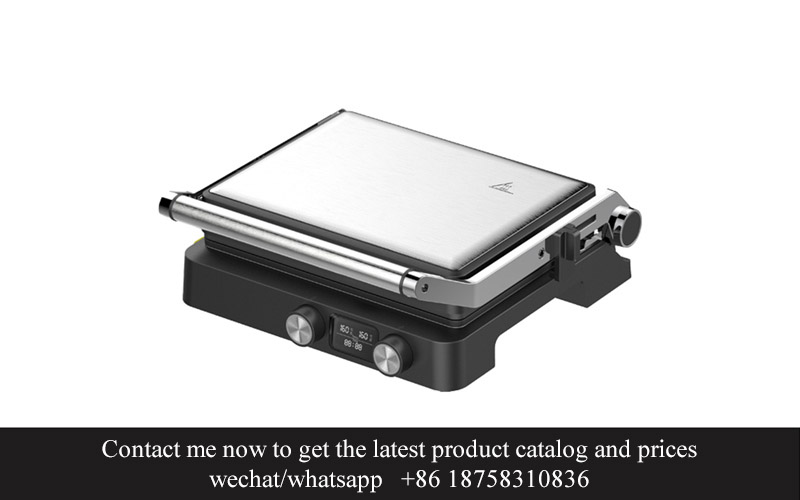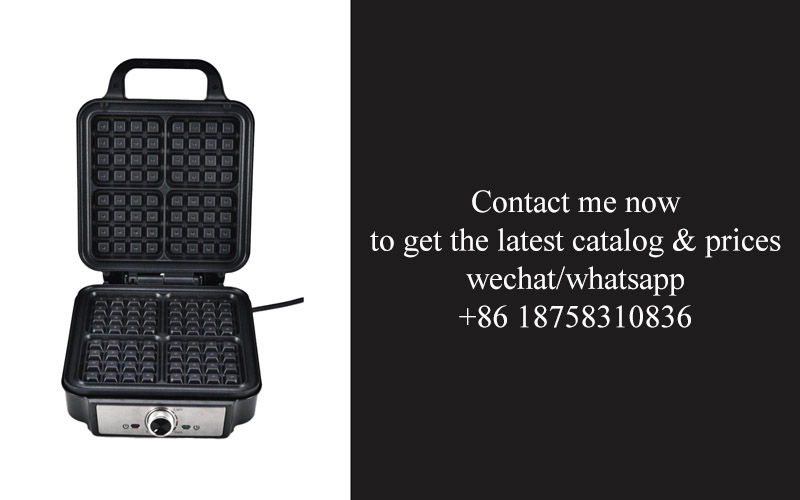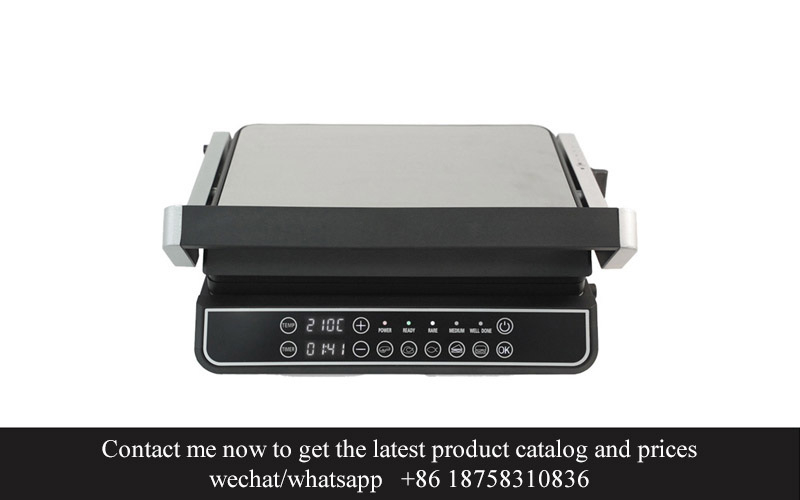Address
304 North Cardinal
St. Dorchester Center, MA 02124
Work Hours
Monday to Friday: 7AM - 7PM
Weekend: 10AM - 5PM
Address
304 North Cardinal
St. Dorchester Center, MA 02124
Work Hours
Monday to Friday: 7AM - 7PM
Weekend: 10AM - 5PM

In the ever-evolving world of kitchen appliances, one technology stands out for its transformative potential: integrated metal stamping. This innovative process has revolutionized the manufacturing of sandwich plates, breathing new life into an industry ripe for innovation. As the demand for high-quality, durable, and aesthetically pleasing kitchenware grows, understanding how integrated metal stamping shapes the sandwich plate market is crucial for anyone looking to stay ahead in this competitive landscape.
The sandwich plate has become more than just a meal carrier; it’s a culinary canvas that showcases both form and function. The design of these plates has evolved significantly, thanks to advancements in technology and materials. One such innovation that has revolutionized the sandwich plate industry is the use of integrated metal stamping. Let’s dive into how this process has become a cornerstone of modern sandwich plate design.
Integrated metal stamping is a metal forming process that uses a stamping press to create shapes from sheets of metal. This method allows for the creation of intricate designs and complex structures with high precision and efficiency. When it comes to sandwich plates, integrated metal stamping has introduced a plethora of innovative features that enhance both the aesthetic and practical aspects of these kitchen essentials.
One of the most noticeable innovations is the sleek, modern aesthetics that integrated metal stamping brings to sandwich plates. The process allows for the creation of unique patterns and textures that add a touch of sophistication to any kitchen setting. From intricate floral designs to geometric patterns, these plates are not just functional but also a statement piece that can elevate the look of a dining table.
But it’s not just about looks; the functionality of sandwich plates has also been dramatically improved through integrated metal stamping. The use of metal stamping allows for the inclusion of features that make these plates more versatile and user-friendly. For instance, the creation of integrated handles or foldable edges can make it easier to transport and store these plates, especially in smaller kitchens or for those who are constantly on the go.
Moreover, the precision of metal stamping ensures that sandwich plates are durable and long-lasting. The metal used in the stamping process is often stainless steel, which is known for its resistance to corrosion and heat. This means that these plates can withstand the rigors of everyday use, including being placed in the microwave or dishwasher without losing their shape or luster.
Another significant benefit of integrated metal stamping is the cost-effectiveness it offers. By automating much of the production process, manufacturers can produce sandwich plates at a lower cost per unit. This affordability makes high-quality sandwich plates accessible to a broader market, from professional chefs to home cooks.
The design possibilities with integrated metal stamping are virtually limitless. Customization is key in today’s market, and the stamping process allows for the creation of plates that cater to specific tastes and preferences. For instance, restaurants and cafes can have their branding embossed onto the plates, providing a unique marketing tool that also serves a practical purpose.
On the consumer front, the rise of food blogs and social media has led to a greater emphasis on presentation. Integrated metal stamping allows sandwich plates to not only hold the food securely but also to be a centerpiece of the meal, encouraging foodies to share their culinary creations with the world.
From a sustainability perspective, the use of metal in sandwich plates is also a positive. Metal is a highly recyclable material, and the longevity of these plates means that they have a lower environmental impact than disposable alternatives. Additionally, the durability of metal ensures that these plates have a long lifespan, reducing the need for frequent replacements.
The integration of metal stamping into sandwich plate design has also influenced the way manufacturers think about product development. The ability to create plates with varying thicknesses and materials, such as combining metal with other materials for insulation, has opened up new avenues for innovation. This has led to the development of insulated sandwich plates that keep food hot or cold for extended periods, making them a favorite among outdoor enthusiasts and those who enjoy picnics.
In conclusion, the role of integrated metal stamping in sandwich plate design is undeniable. It has brought about a new era of elegance, functionality, and sustainability to the humble sandwich plate. As the culinary world continues to evolve, we can expect to see even more groundbreaking designs emerge, all thanks to the precision and versatility of metal stamping technology.

Integrated metal stamping is a precision manufacturing process that has revolutionized the production of various components, including those found in kitchen appliances. This method involves the use of high-pressure dies to shape metal sheets into complex three-dimensional forms. Here’s a closer look at the process and its significance.
The core of integrated metal stamping lies in the design and construction of the dies, which are the molds that shape the metal. These dies are typically made from hardened steel and are precision-engineered to ensure accurate and consistent production. The metal sheets, often made from materials like stainless steel or aluminum, are fed into the die, where they undergo a series of stamping operations that can include cutting, bending, forming, and deep drawing.
One of the key advantages of integrated metal stamping is its efficiency. The process allows for high-volume production with minimal waste, as the metal is formed into the desired shape with a single operation or a sequence of closely timed operations. This streamlines the manufacturing process and reduces production times, making it an ideal choice for mass-producing components like sandwich plates.
The precision of integrated metal stamping is unmatched in many applications. The dies are designed to ensure tight tolerances, which means the stamped parts are uniform in size and shape. This level of precision is crucial for sandwich plates, as they need to fit together seamlessly and securely to hold food in place during cooking.
Another notable aspect of integrated metal stamping is its versatility. The process can be adapted to create a wide range of shapes and sizes, allowing manufacturers to design sandwich plates with unique features and functions. For example, the edges of the plates can be designed with ridges or channels to improve grip or to provide a non-slip surface.
The material used in the stamping process also plays a vital role. Stainless steel, for instance, is a popular choice for its durability and resistance to corrosion, making it ideal for kitchenware that comes into contact with food and heat. Aluminum, on the other hand, offers a lighter weight alternative with excellent heat conductivity, which can be beneficial for certain cooking applications.
In the context of sandwich plates, integrated metal stamping can be used to create a variety of features that enhance the user experience. These might include integrated handles for easy transport, recessed areas for drip prevention, or even specialized surfaces that promote even heating or non-stick properties.
The environmental benefits of integrated metal stamping cannot be overlooked. The process minimizes material waste and energy consumption, contributing to a more sustainable manufacturing practice. By using recycled materials and optimizing the production process, manufacturers can reduce their carbon footprint and contribute to a greener future.
As technology advances, the capabilities of integrated metal stamping continue to expand. The development of new materials and the refinement of die-making techniques have opened up new possibilities for sandwich plate design. For example, the introduction of high-strength alloys allows for the creation of plates that are both lightweight and extremely durable.
The quality control aspect of integrated metal stamping is also a significant factor. The process allows for consistent inspection and adjustment during production, ensuring that each sandwich plate meets the highest standards of quality. This attention to detail is essential for maintaining brand reputation and customer satisfaction.
In conclusion, integrated metal stamping is a pivotal technology in the production of sandwich plates. Its efficiency, precision, versatility, and environmental benefits make it a compelling choice for manufacturers looking to create innovative and high-quality kitchenware. As the industry evolves, the role of integrated metal stamping is likely to become even more integral to the design and production of advanced sandwich plates and other kitchen appliances.

The sandwich plate, a seemingly simple culinary staple, has quietly been revolutionizing the way we enjoy our meals. Its rise in popularity isn’t just a fleeting trend; it’s a game-changer for the culinary world, bringing with it a host of benefits that extend beyond the mere act of eating.
From the traditional ham and cheese sandwich to the gourmet creations that have been popping up on menus across the globe, the sandwich plate has become a canvas for culinary innovation. It’s a versatile format that allows for an endless array of flavors, textures, and ingredients, making it a favorite among chefs and food enthusiasts alike.
One of the most compelling aspects of the sandwich plate is its ability to bring together diverse elements in a harmonious blend. Imagine a layer of tender, slow-cooked brisket, followed by a rich, smoky aioli, a sprinkle of crispy arugula, and a drizzle of balsamic reduction. Each component adds its own unique touch, creating a symphony of taste and texture that is both satisfying and visually stunning.
The sandwich plate also offers a platform for showcasing seasonal ingredients. Chefs can craft sandwiches that highlight the freshest produce available, ensuring that each bite is a celebration of the harvest. Whether it’s a springtime salad with asparagus and goat cheese or a fall-inspired applewood-smoked turkey with honey-cider glaze, the sandwich plate allows for a dynamic and ever-changing menu.
Moreover, the format is incredibly user-friendly. It provides a structured way to present a meal, ensuring that each element is proportioned perfectly. This isn’t just about portion control; it’s about the experience. The sandwich plate encourages the diner to engage with the food, to take their time and savor each layer, creating a more thoughtful and enjoyable dining experience.
In the realm of street food and casual dining, the sandwich plate has become a staple. It’s the perfect vessel for quick, yet satisfying meals that are easy to grab and go. Whether you’re sipping on a coffee and munching on a classic BLT or enjoying a gourmet burger at a food truck festival, the sandwich plate is a convenient and delicious choice.
On the health and wellness front, the sandwich plate is also making waves. With the rise of clean eating and mindful snacking, the format allows for the creation of balanced meals that are packed with nutrients. You can have a lean protein, a complex carbohydrate, and a serving of vegetables all in one compact package, making it an excellent choice for those looking to maintain a healthy diet.
The sandwich plate has also transcended its origins in Western cuisine. Chefs around the world are putting their own cultural spins on this format, blending local flavors and techniques. We see it in Japanese-style bento boxes, filled with sushi rice and pickled vegetables, or in Indian chaat, where savory snacks are served in a variety of combinations.
But it’s not just about the flavors; the sandwich plate is also a marvel of design. The art of plating has become increasingly important in the culinary world, and the sandwich plate provides a canvas for creativity. Chefs are experimenting with presentation, using ingredients not just for taste but also for visual appeal. From the perfect patina on a crusty roll to the artful arrangement of toppings, the sandwich plate is a feast for the eyes as well as the palate.
The versatility of the sandwich plate is unmatched. It can be a simple, comforting meal or a complex, gourmet experience. It can be enjoyed at home, in a café, or on the go. It can cater to dietary restrictions or simply satisfy a craving for something delicious. Its adaptability is what has made it such a hit in the culinary landscape.
In the world of food service, the sandwich plate has also streamlined the process. It allows for efficient food prep, easy service, and quick turnaround times. For restaurants looking to offer a variety of items without cluttering their menus, the sandwich plate is a practical solution.
In conclusion, the sandwich plate is more than just a meal—it’s a culinary phenomenon. It’s a format that has the power to bring people together, to inspire creativity, and to transform the way we think about food. Whether you’re a seasoned chef or a casual eater, the sandwich plate is a game-changer that is here to stay.

Integrated metal stamping has revolutionized the manufacturing process of sandwich plates, transforming the way these versatile kitchen essentials are produced and used. Here’s a closer look at why this technology has become a game-changer for the sandwich plate industry:
The Precision of Integrated Metal StampingMetal stamping offers unparalleled precision, ensuring that each sandwich plate is uniform in size, shape, and thickness. This level of consistency is crucial for the durability and functionality of sandwich plates, as it allows for a perfect fit when stacked or used in layered dishes.
Improved Strength and DurabilityThe process of integrated metal stamping results in sandwich plates that are not only precise but also incredibly strong. The high-quality metal used in stamping can withstand the rigors of daily use, including being stacked, dropped, or exposed to heat, making these plates a reliable choice for both home and commercial kitchens.
Customization at ScaleOne of the standout advantages of integrated metal stamping is the ability to customize sandwich plates to meet specific design and functional requirements. Whether it’s adding non-slip pads, incorporating drainage systems, or creating unique shapes and sizes, the stamping process allows for a high degree of personalization without compromising on production efficiency.
Cost-Effective ProductionWhile the initial investment in a metal stamping machine may be significant, the long-term benefits are substantial. The efficiency of the process means that manufacturers can produce a large number of sandwich plates in a short amount of time, reducing labor costs and increasing output. This cost-effectiveness is a major draw for businesses looking to scale up their sandwich plate production.
Enhanced Food SafetyFood safety is a top priority in the kitchen, and integrated metal stamping contributes to this by providing a smooth, non-porous surface on sandwich plates. This surface is easier to clean and less likely to harbor bacteria, making it a safer choice for food preparation and storage.
Streamlined Assembly and DisassemblyThe design of sandwich plates crafted through integrated metal stamping often includes features that make them easier to assemble and disassemble. This is particularly beneficial in commercial settings where speed and efficiency are key to maintaining a smooth workflow.
Versatility in Material OptionsMetal stamping allows for the use of various metals, each with its own unique properties. From stainless steel for its corrosion resistance and durability to aluminum for its lightweight nature, the choice of material can be tailored to the specific needs of the end-user, whether it’s for residential or commercial use.
Longevity and Reduced WasteThe robustness of sandwich plates made through integrated metal stamping means they are designed to last longer, reducing the frequency of replacements and the associated waste. This sustainable approach is not only environmentally friendly but also cost-effective for consumers and businesses alike.
Innovation in Design and FunctionalityThe technology of integrated metal stamping has spurred innovation in the design of sandwich plates. Manufacturers can now experiment with different shapes, sizes, and features, leading to a variety of products that cater to diverse culinary needs and preferences.
Adaptability to Market TrendsAs market trends evolve, the sandwich plate industry must adapt to meet changing consumer demands. Integrated metal stamping enables quick adjustments to production, allowing manufacturers to respond swiftly to new design trends or functional requirements without a significant delay in production.
The Impact on the IndustryThe adoption of integrated metal stamping has had a profound impact on the sandwich plate industry. It has raised the bar for quality, efficiency, and customization, setting new standards for what is expected from kitchenware products. This shift has not only benefited manufacturers but has also improved the overall experience for end-users.
In conclusion, integrated metal stamping has become a game-changer for sandwich plates by enhancing their precision, strength, and customization options. It has also contributed to cost savings, improved food safety, and sustainability, making it a pivotal technology in the evolution of kitchenware manufacturing.

Integrated metal stamping has revolutionized the production of sandwich plates, transforming the quality and durability of these essential kitchenware items. This process involves the creation of intricate shapes and patterns through the deformation of metal sheets, resulting in a wide range of benefits that enhance the overall performance of sandwich plates.
The precision and consistency of the metal stamping process ensure that each sandwich plate is uniform in size and shape, which is crucial for a seamless dining experience. The uniformity also extends to the thickness of the metal, which is carefully controlled to provide the right balance of strength and flexibility. This balance is essential for sandwich plates to withstand the pressure of being filled with various ingredients without bending or warping.
One of the key advantages of integrated metal stamping is the ability to create complex designs and features that enhance the aesthetic appeal of sandwich plates. From subtle textures to intricate patterns, the process allows for a level of customization that was previously unattainable with traditional manufacturing methods. These designs not only make the plates visually appealing but can also serve practical purposes, such as providing grip or preventing sliding on surfaces.
The strength and longevity of sandwich plates are significantly improved through the metal stamping process. The metal sheets used are typically high-quality stainless steel, which is known for its corrosion resistance and durability. The stamping process forms the metal into a single, solid piece, eliminating the need for multiple points that can weaken the structure over time. This solid construction means that sandwich plates can endure the rigors of daily use, including exposure to heat, moisture, and various cleaning agents.
Another aspect of the metal stamping process that contributes to the quality of sandwich plates is the precision of the edges. The stamping machines are capable of creating sharp, clean edges that are less likely to chip or break compared to those found on plates made using other methods. This attention to detail ensures that the sandwich plates are not only functional but also safe for use, as rough or sharp edges can pose a risk to users.
The efficiency of the metal stamping process also plays a role in the quality of sandwich plates. By automating much of the manufacturing process, companies can produce a high volume of plates with minimal waste. This streamlined production not only reduces costs but also ensures that each plate meets the same high standards, leading to a consistent product that customers can rely on.
In terms of environmental impact, integrated metal stamping is a more sustainable choice. The precision of the process means that less material is wasted, and the use of high-quality metals like stainless steel ensures that the plates have a longer lifespan, reducing the need for frequent replacements. This not only benefits the consumer but also contributes to a more sustainable approach to manufacturing.
The surface finish of sandwich plates is also greatly enhanced by the metal stamping process. The smooth, polished surfaces are not only visually pleasing but also easier to clean, a crucial factor for those who appreciate a quick and efficient clean-up after enjoying a meal. The finish can also be tailored to meet specific design requirements, whether it’s a glossy sheen or a matte texture.
Lastly, the versatility of the integrated metal stamping process allows for the creation of sandwich plates with various features, such as built-in non-slip pads or handles for easy transport. These features can be seamlessly integrated into the design, ensuring that the plates are not only functional but also user-friendly.
In conclusion, the integrated metal stamping process has transformed the quality of sandwich plates by offering precision, durability, aesthetic appeal, and sustainability. From the uniformity of shape and strength to the intricate designs and practical features, this process has set a new standard for what we expect from our kitchenware, making sandwich plates a game-changer in the culinary world.

The demand for high-quality sandwich plates has seen a remarkable surge in recent years, reshaping the culinary landscape and influencing consumer preferences. This growth is driven by several factors that highlight the importance of these versatile kitchen essentials.
Evolving Dietary Trends: As people become more health-conscious, there’s been a shift towards meals that are not only delicious but also nutritious. Sandwich plates, with their ability to accommodate a variety of ingredients and condiments, have become a staple in meal prep. Their convenience in serving open-faced sandwiches, salads, and even as a base for dips and spreads has made them a favorite among busy individuals and food enthusiasts.
Customization and Personalization: Modern consumers are looking for products that cater to their unique tastes and preferences. High-quality sandwich plates often feature customizable designs, allowing users to express their personalities through the tableware they choose. This emphasis on personalization has created a niche market for innovative and unique sandwich plates.
Sustainability Focus: With the increasing awareness of environmental issues, there’s a growing preference for eco-friendly products. High-quality sandwich plates that are made from recycled materials or designed to be easily recyclable are gaining popularity. This sustainable approach aligns with consumer values and contributes to the rising demand for these plates.
Culinary Exploration: The sandwich plate has evolved from a simple bread and cheese meal to a canvas for culinary creativity. Chefs and home cooks alike are experimenting with flavors and textures, pushing the boundaries of traditional sandwiches. This exploration has led to a demand for sandwich plates that can withstand the rigors of different ingredients and cooking methods, from raw vegetables to hot fillings.
Cultural Influence: The globalization of food has introduced new flavors and cooking styles to various regions. This cultural exchange has sparked a demand for sandwich plates that can cater to a diverse range of cuisines, from Italian paninis to Japanese bento boxes. High-quality sandwich plates that offer versatility in design and material are perfectly suited to accommodate these global influences.
Health and Hygiene: With the emphasis on food safety and hygiene, sandwich plates that are easy to clean and maintain are in high demand. The use of high-quality materials and non-porous finishes ensures that these plates are resistant to bacteria growth, making them a preferred choice for health-conscious consumers.
Versatility in Usage: Sandwich plates are no longer just for serving sandwiches. They have become a versatile serving option for a variety of dishes, from appetizers to desserts. This versatility has expanded their appeal, making them a must-have item in many kitchens.
Innovation in Functionality: Advances in technology and material science have led to the development of sandwich plates with innovative features. For example, some plates come with built-in dividers, making it easier to separate different ingredients. Others are designed to keep food warm or cold, enhancing the dining experience.
Economic Factors: As the cost of living continues to rise, consumers are seeking affordable solutions that provide value for money. High-quality sandwich plates that offer durability and a long lifespan are seen as a cost-effective investment, contributing to their growing demand.
Marketing and Branding: The way sandwich plates are marketed and branded has also played a significant role in their popularity. Brands that tell a compelling story, whether it’s about quality, sustainability, or culinary innovation, have been able to resonate with consumers and drive demand.
In conclusion, the demand for high-quality sandwich plates is on the rise due to a combination of evolving dietary trends, a focus on customization and sustainability, cultural influences, health concerns, versatility, innovation, economic factors, and effective marketing strategies. As these factors continue to shape consumer preferences, the market for high-quality sandwich plates is poised to expand further.

The rise of the modern sandwich plate has been nothing short of a revolution in the culinary world. These innovative plates are not just functional; they are a statement of style and quality. Let’s delve into the design trends that have made these sandwich plates stand out.
The sleek, minimalist aesthetic is a hallmark of contemporary sandwich plates. They often feature clean lines and a lack of unnecessary embellishments, which appeals to those who appreciate simplicity and functionality. This design philosophy has led to a range of plates that are both visually appealing and practical for everyday use.
One of the key trends is the integration of eco-friendly materials. As consumers become more environmentally conscious, sandwich plates made from recycled metals or sustainable materials are gaining popularity. These plates are not only durable but also send a message about the brand’s commitment to sustainability.
Color plays a significant role in the design of modern sandwich plates. While traditional metal finishes remain popular, there’s a growing trend towards vibrant colors and unique finishes. From brushed copper to glossy black, the variety of colors and textures adds a touch of personality to the kitchen and enhances the visual appeal of the food placed on them.
The inclusion of smart features is another trend that sets modern sandwich plates apart. Some designs come with built-in temperature controls or non-stick coatings that make them perfect for cooking and serving a variety of dishes. This blend of form and function caters to the needs of food enthusiasts who want their kitchenware to be as versatile as their culinary skills.
The size and shape of sandwich plates have also evolved. While traditional round plates are still common, there’s a shift towards more geometric and unconventional shapes. Rectangular plates with slightly elevated edges, for example, provide more surface area for creative plating and can accommodate larger sandwiches or a variety of side dishes.
The handles and grip of these plates are also a point of innovation. Ergonomic designs and non-slip surfaces make it easier to carry and serve food, reducing the risk of spills and accidents. This thoughtful design consideration is particularly appreciated in busy households or restaurants where safety and ease of use are paramount.
The trend towards personalization is also evident in the design of sandwich plates. Customizable options, such as laser engraving or the ability to choose from a selection of handle shapes and sizes, allow users to create a plate that reflects their individual style or brand identity.
In terms of material, there’s a trend towards using high-quality, food-grade metals. Stainless steel remains a favorite due to its durability and resistance to rust and stains, but other metals like aluminum and copper are also gaining traction for their unique properties and aesthetic appeal.
The use of innovative technologies in the manufacturing process has also contributed to the design trends. Techniques like laser cutting and 3D printing are allowing for more intricate and detailed designs that were once impossible to achieve. This has opened up a world of possibilities for designers and consumers alike.
Lastly, the rise of social media and food blogging has had a significant impact on sandwich plate design. The desire to create visually stunning food presentations has led to the creation of plates that are as much a part of the culinary experience as the food itself. These plates are not just for eating; they are for sharing and showcasing the artistry of the meal.
In summary, modern sandwich plates stand out due to their minimalist aesthetic, eco-friendly materials, vibrant colors, smart features, unique shapes, ergonomic designs, personalization options, high-quality materials, innovative manufacturing processes, and their role in the food presentation trend. These factors have combined to create a product that is not only a game-changer in the culinary world but also a symbol of the evolving expectations and tastes of modern consumers.

The adoption of integrated metal stamping technology has revolutionized the sandwich plate industry, leading to a surge in successful case studies where this innovative process has enhanced both the efficiency and quality of sandwich plates. From compact kitchens to bustling cafes, the impact of integrated metal stamping is undeniable. Here are a few case studies that showcase the effectiveness of this method:
In one such case, a mid-sized foodservice company found that the switch to integrated metal stamping for their sandwich plates resulted in a significant reduction in manufacturing time. By streamlining the production process, they were able to increase their output without compromising on quality. The precise and efficient stamping allowed for intricate designs and stronger, more durable sandwich plates, which were well-received by their customers.
Another example comes from a global brand known for its gourmet sandwiches. They were struggling with the inconsistencies in the thickness and shape of their sandwich plates, which were affecting the overall customer experience. After implementing integrated metal stamping, they noticed a marked improvement in the uniformity of the plates. The consistency in thickness and the clean, precise edges led to a more appealing and professional presentation, boosting their brand image and customer satisfaction.
In a different scenario, a local bakery chain faced challenges with the durability of their sandwich plates, which were prone to bending and breaking during the high-traffic lunchtime rush. By opting for integrated metal stamping, the bakery was able to produce plates that could withstand the rigors of constant use. The increased strength not only enhanced the longevity of the plates but also saved the bakery from the costs associated with frequent replacements.
One innovative food truck operator has embraced integrated metal stamping to create sandwich plates that not only stand out visually but also serve as a practical solution for their mobile kitchen. The plates are designed to be lightweight yet sturdy, making them easy to transport and stack for maximum efficiency. The case study highlights how this technology has enabled the food truck to maintain a high standard of food presentation on the move.
For a gourmet food company specializing in gourmet sandwiches, the use of integrated metal stamping allowed for the creation of custom-designed sandwich plates that matched the company’s high-end image. The detailed, custom stamping not only added a unique aesthetic appeal but also ensured a tight fit for various toppings and fillings, which was essential for maintaining the integrity of their gourmet creations.
In the fast-paced world of retail sandwich shops, where speed and efficiency are crucial, integrated metal stamping has become a game-changer. A leading sandwich retailer was able to reduce their preparation time by using stamped sandwich plates that could be easily assembled with fillings. The uniformity of the plates also facilitated a quicker and more accurate service, which was a significant factor in their customer satisfaction scores.
The case studies also show how integrated metal stamping has allowed for environmental considerations. A sustainable sandwich brand was able to create sandwich plates made from recycled metals, which were both durable and eco-friendly. The process of stamping enabled the creation of plates with intricate patterns that communicated the brand’s commitment to sustainability, while the long-lasting nature of the plates reduced waste over time.
In each of these case studies, the common thread is the transformative power of integrated metal stamping. By providing a solution that increases efficiency, improves product quality, and allows for customization and innovation, this technology has become a key driver in the sandwich plate industry. From large-scale manufacturers to niche businesses, the impact of integrated metal stamping is clear: it’s not just about creating sandwich plates; it’s about crafting the future of culinary presentation and experience.

In the evolving world of kitchenware, sandwich plates have become a staple, not just for their utility but for their innovative design and quality. As we delve into the future prospects of the sandwich plate industry, it’s clear that several factors are shaping its trajectory. Here are some predictions that highlight the industry’s potential growth and transformation:
The Rise of CustomizationWith consumer tastes becoming more varied and discerning, the future of sandwich plates will likely see a significant rise in customization options. Brands are anticipated to offer a broader range of finishes, sizes, and designs, allowing users to create a sandwich plate that perfectly complements their personal style and kitchen decor.
Eco-Friendly MaterialsThe demand for eco-conscious products is growing, and the sandwich plate industry is expected to follow suit. We may see a surge in plates made from recycled materials, sustainable resources, and biodegradable compounds. This shift is not just driven by environmental concerns but also by the desire of consumers to reduce their carbon footprint in daily life.
Smart and Multi-Functional PlatesTechnology is creeping into the kitchen in more ways than ever, and sandwich plates are no exception. The industry could see an influx of smart sandwich plates with integrated features like temperature control, non-stick coatings that make them ideal for microwave use, and even built-in sensors that monitor food safety.
Enhanced DurabilityWith the rise of on-the-go lifestyles, durability has become a key factor in sandwich plate design. Expect to see more robust materials and innovative manufacturing processes that ensure plates are not just resistant to wear and tear but also easy to clean and maintain over time.
Global Market ExpansionThe sandwich plate market is poised for significant growth as it expands beyond its traditional demographics. As international culinary trends merge and evolve, there will be an increasing demand for sandwich plates in countries where this format isn’t as common, such as in some Asian and South American markets.
Collaboration with Chefs and DesignersBrands that partner with chefs and designers are likely to gain a competitive edge. Collaborations could lead to the creation of limited-edition sandwich plates that cater to specific recipes or seasonal dishes, thereby appealing to both casual diners and culinary enthusiasts.
The Integration of New Cooking TechniquesWith the emergence of sous-vide and other precise cooking methods, sandwich plates might be adapted to cater to these new culinary trends. We could see plates designed to retain heat or cold for longer periods, ensuring that the sandwich experience is enhanced from start to finish.
Market SegmentationAs the market for sandwich plates grows, it may also become more segmented. There could be a distinction between mass-market and premium brands, with the latter offering higher-quality materials and artisanal designs that appeal to a niche audience.
Regulatory Compliance and Safety StandardsThe industry is likely to face increased scrutiny in terms of food safety and safety standards. This means that companies will have to invest in high-quality manufacturing processes that ensure their products meet stringent health codes, both locally and globally.
E-Commerce and Direct-to-Consumer ModelsThe rise of e-commerce and the direct-to-consumer model could disrupt traditional supply chains. Companies that embrace these new retail avenues may be able to offer competitive pricing, better customer service, and more personalized product experiences.
In conclusion, the sandwich plate industry is set for a dynamic period marked by innovation, customization, and a strong focus on consumer preferences and sustainability. By keeping up with these trends and adapting to changing market demands, companies can ensure they remain at the forefront of this burgeoning market.

The integration of metal stamping into the production of sandwich plates has ushered in a new era of innovation within the kitchen appliances market. This technology has not only enhanced the quality and durability of sandwich plates but has also significantly impacted the way these essential kitchen tools are perceived and utilized. Let’s delve into the multifaceted impact of integrated metal stamping on the sandwich plate industry.
Metal stamping’s precision and consistency in creating intricate designs and shapes have revolutionized the aesthetics of sandwich plates. Once limited to simple, uniform designs, these plates now boast unique patterns and contours that cater to a wide range of culinary styles and personal preferences.
The efficiency of the metal stamping process has also led to cost reductions, making high-quality sandwich plates more accessible to a broader market. This affordability, combined with the superior performance of metal-stamped plates, has fueled a surge in consumer demand.
In terms of durability, the strength and resilience of metal-stamped sandwich plates are unparalleled. They can withstand the rigors of daily use, including exposure to high temperatures and harsh cleaning agents, without warping or deforming. This longevity has reduced the frequency of replacements, further contributing to cost savings for consumers.
The introduction of metal stamping has also allowed for the creation of sandwich plates with enhanced functionality. Innovative features such as built-in non-stick coatings, ergonomic handles, and integrated heat-resistant materials have transformed the way people prepare and serve meals.
Another notable impact of metal stamping on sandwich plates is the reduction of waste. Traditional manufacturing methods often result in a higher percentage of scrap material, but the precision of metal stamping minimizes waste, aligning with the growing emphasis on sustainability in the kitchenware industry.
The adoption of metal stamping technology has also driven a wave of competition within the sandwich plate market. Companies are constantly pushing the boundaries of design and functionality, leading to a diverse array of options that cater to specific consumer needs and trends.
From a retail perspective, the presence of metal-stamped sandwich plates on store shelves has expanded the product offerings, creating new opportunities for retailers to attract and retain customers. The versatility of these plates, which can be used for a variety of dishes, from traditional sandwiches to gourmet meals, makes them a staple in many kitchens.
On a global scale, the integration of metal stamping into sandwich plate production has opened up new markets. As the technology becomes more widespread, international demand for high-quality kitchenware is on the rise, creating new avenues for growth and expansion for manufacturers and distributors.
The impact of metal stamping on the sandwich plate industry is not just limited to the product itself. It has also influenced the way manufacturing processes are viewed within the kitchen appliances market. The emphasis on precision, efficiency, and innovation has set a new standard for quality, prompting other manufacturers to adopt similar technologies to stay competitive.
In conclusion, the integration of metal stamping into the production of sandwich plates has had a profound impact on the kitchen appliances market. It has transformed the design, durability, functionality, and sustainability of these essential kitchen tools, making them more appealing and accessible to consumers worldwide. As the technology continues to evolve, the future of sandwich plates looks promising, with endless possibilities for innovation and improvement.